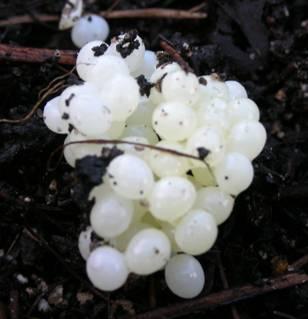Iberian slug IPM
Elements in an integrated pest management protocol of the invasive Iberian slug, Arion vulgaris, in agriculture

Main content
Invasive species, which in many cases have been introduced by man, are an increasing threat to today’s ecosystems. The Iberian slug Arion vulgaris (previously regarded as A. lusitanics) is an invasive species dispersing through large parts of Europe and causing considerable damage to gardens, horticulture and agriculture. It is possible that this slug displaces or hybridizes with native species such as the Black slug, Arion ater. The invasive nature of this slug species calls for research into its taxonomy and biology as well as its natural enemies.
The current NFR-funded project for 2009-2012 shall develop an Integrated Pest Management Protocol for Arion vulgaris in field-grown crops such as strawberries, vegetables, and managed grasslands.
This will be achieved through studying the following:
- Use of barriers - we will test the hypothesis that barriers can be effective in stopping the Iberian slug gaining access into agricultural fields.
- Winter mortality - we will investigate the hypothesis that the Iberian slug experiences high mortality when overwintering in agricultural fields.
- Use of molluscicides – we will test the impact of iron phosphate baited molluscides on slug pest populations in agricultural fields.
- Sub-lethal effects of mollusc parasites and molluscicides - potential effects of nematode parasites and molluscicides on reproduction will be tested.
- The role of parasites and predators in regulating Iberian slug populations - the hypothesis that slug-parasitic nematodes reduce or regulate A. vulgaris populations in a chosen area will be tested. We will test the hypothesis that naturally occurring predatory beetles and snails are significant predators of the Iberian slug. We will also test if measures to increase predator and parasite abundance leads to reduced populations of the Iberian slug.
- The distribution of the Iberian slug in Hordaland - the current distribution will be explored, as an example of anthropological spreading of an invasive species.
The project uses morphology and DNA to distinguish between large slugs and potential hybrids. Population densities are measured by quadrat searching, counting and weighing slugs in the vegetation down to the soil surface. Predation is studied using feeding experiments in the laboratory and in semi-field experiments. Predation is also studied in the field using DNA analyses screening the gut contents of predators.
Research highlights
- Carabid and staphylinid beetles feed on A. vulgaris as eggs or small juveniles, but only large carabid beetles (e.g. Carabus nemoralis) consume larger juveniles.
- Predation in the field by carabid beetles is most significant in spring and seems to be density dependent without any clear preferences between slug species.
Researchers: Bjørn Arild Hatteland (BIO, UiB) and Steffen Roth (Bergen Museum, UiB) (and continuing work from the late Torstein Solhøy (BIO, UiB))
Master student: Elisa Pianezzola (Padova University, Italy and Bio, UiB)
Collaborators: Arild Andersen (Bioforsk) and Solveig Haukeland (Bioforsk)
International collaborators: William Symondson (Cardiff University, UK) molecular methods in the study of predation, particularly of pest insects and slugs; Leslie Noble (Aberdeen University, UK) slug taxonomy and molecular techniques; Ted von Proschwitz (Gothenburg University, Sweden) slug taxonomy and ecology
Publications
Hatteland, B.-A., Symondson, W.O.C., King, R.A., Skage, M., Schander, C. & Solhøy, T. (2011) Molecular analysis of predation by carabid beetles (Carabidae) on the invasive Iberian slug Arion lusitanicus. Bulletin of Entomological Research 101: doi: 10.1017/S0007485311000034
Hatteland, B.-A., Grutle, K., Mong, C.E., Skartveit, J., Symondson, W.O.C. & Solhøy, T. (2010)Predation by beetles (Carabidae, Staphylinidae) on eggs and juveniles of the Iberian slug Arion lusitanicus in the laboratory. Bulletin of Entomological Research 100: 559-567. doi: 10.1017/S0007485309990629
